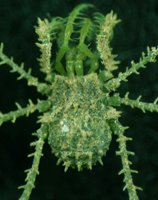- Laniatores
Taxobox
name = Laniatores

image_caption =Podoctidae from the Philippines
regnum =Animal ia
phylum =Arthropoda
classis =Arachnida
ordo =Opiliones
subordo = Laniatores
subordo_authority = Thorell, 1876
subdivision_ranks = Superfamilies
subdivision =Travunioidea Triaenonychoidea Epedanoidea Phalangodoidea Samooidea Zalmoxoidea Gonyleptoidea Laniatores is the largest suborder of the
arachnid orderOpiliones with over 4,000 described species worldwide. The majority of the species are highly dependent on humid environments and usually correlated with tropical and temperate forest habitats.Laniatores are typically (relatively) short-legged, hard-plated, spiny Opiliones, common under logs and stones, in
leaf litter and incave s. They often have spinypedipalp s and paired or branched claws on the third and fourth pairs of legs [Pinto-da-Rocha "et al." 2007: 17] .The largest family isGonyleptidae Sundevall, 1833, endemic of theNeotropics , with over 800 valid species and showing many cases of maternal and paternal care.Diagnosis
Dorsal scutum consisting in a single piece,carapace orpeltidium entirely fused with abdominal scutum.Pedipalpus usually robust and armed with strong spines.Ovipositor short, unsegmented (derived character state shared with the Dyspnoi). Penis complex, with manysclerite s, some movable, a single penial muscle present, but mostly penis without any muscles, working byhemolymph pressure.Subtaxa
*Infraorder "
Insidiatores " Loman, 1900 (probably diphyletic)
**SuperfamilyTravunioidea Absolon & Kratochvil, 1932
**SuperfamilyTriaenonychoidea Sørensen, 1886
*InfraorderGrassatores Kury, 2002
**SuperfamilyEpedanoidea Sørensen, 1886
**SuperfamilyPhalangodoidea Simon, 1879
**SuperfamilySamooidea Sørensen, 1886
**SuperfamilyZalmoxoidea Sørensen, 1886
**SuperfamilyGonyleptoidea Sundevall, 1833Definitions and limits of superfamilies are still in a state of flux. The largest by far is the Gonyleptoidea, with almost 2,500 described species.
Geographic distribution
Distribution of subunits of Laniatores is very interesting from the biogeographic point of view. The Travunioidea are typical of northern temperate regions while the Triaenonychoidea make their counterpart in the southern temperate regions. The other superfamilies are tropical, with many noteworthy endemisms and transcontinental relationships.
Footnotes
References
* (eds.) (2007): Harvestmen - The Biology of Opiliones. "Harvard University Press" ISBN 0-674-02343-9
Wikimedia Foundation. 2010.
